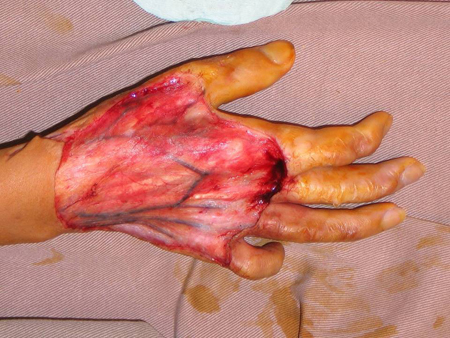Differentials
Hypertrophic scar
SIGNS / SYMPTOMS
No association with skin type.
Always preceded by injury.
On physical examination there may be evidence of contractures. [Figure caption and citation for the preceding image starts]: A hypertrophic scar before excision to correct contraction deformity following a burnFrom the collection of Professor Andrew Burd, used with permission [Citation ends]. [Figure caption and citation for the preceding image starts]: Contraction deformity of little finger corrected by excisionFrom the collection of Professor Andrew Burd, used with permission [Citation ends].
[Figure caption and citation for the preceding image starts]: Contraction deformity of little finger corrected by excisionFrom the collection of Professor Andrew Burd, used with permission [Citation ends].
INVESTIGATIONS
Diagnosis is clinical.
Immunohistochemistry demonstrates flatter, less distinct bundles of fibres, presence of myofibroblasts, and increased density of blood vessels and cells; dermal nodules are present.
Dermatofibrosarcoma protuberans
SIGNS / SYMPTOMS
Clinically, often starts as an asymptomatic papule or nodule, but the skin can appear to be normal on inspection. The skin lesion is contiguous with a palpable tumour that arises from the dermis and spreads into the underlying tissue.
INVESTIGATIONS
Diagnosis may be difficult; histological examination is necessary when there is doubt. This demonstrates neoplastic spindle-shaped nuclei.
An incisional biopsy with a large sample is required.
Dermatofibroma
SIGNS / SYMPTOMS
Usually, no precipitating trauma but similar slow growth.
Clinically, may appear as raised skin nodule but may have subdermal extension.
INVESTIGATIONS
Skin biopsy demonstrates proliferation of fibroblasts and dermal fibrosis.
Giant cell fibroblastoma
SIGNS / SYMPTOMS
Clinically presents as a firm irregular nodule, which may be tender on palpation. Affects mostly pre-pubertal children with the trunk being the most common location.[23] Although locally aggressive, metastases have not been reported.
INVESTIGATIONS
Biopsy demonstrates a nodular mass composed of spindle cells with scattered giant cells occupying most of the reticular dermis.
Use of this content is subject to our disclaimer